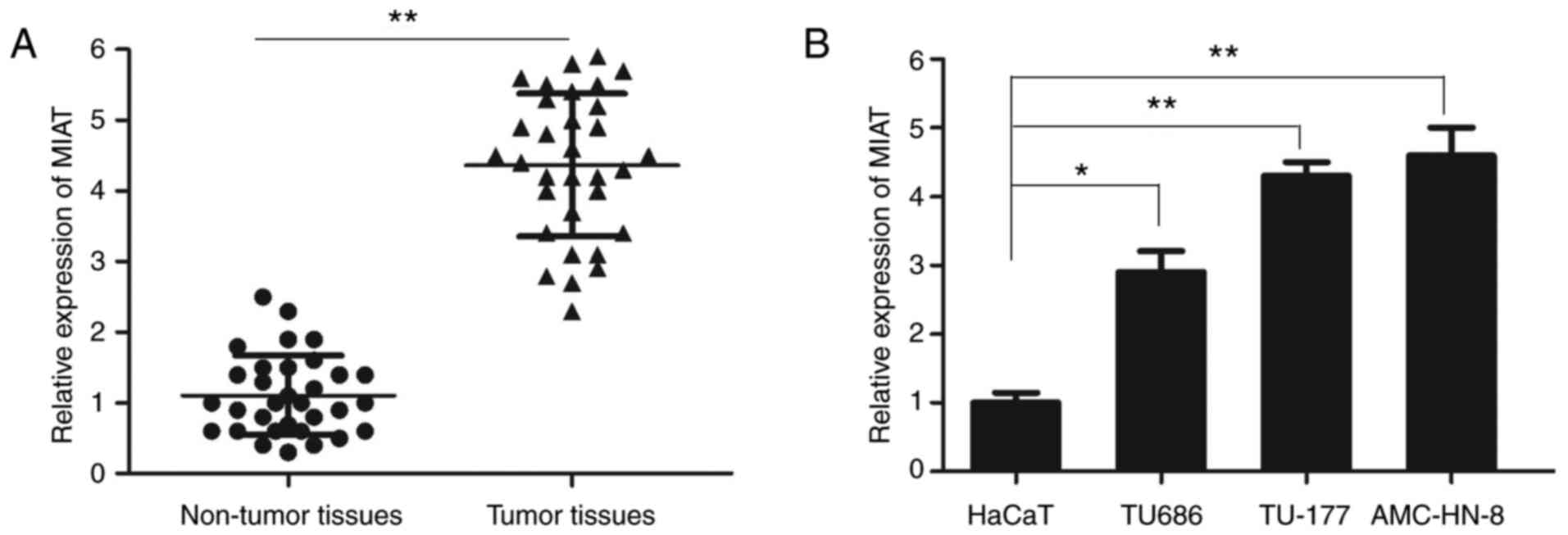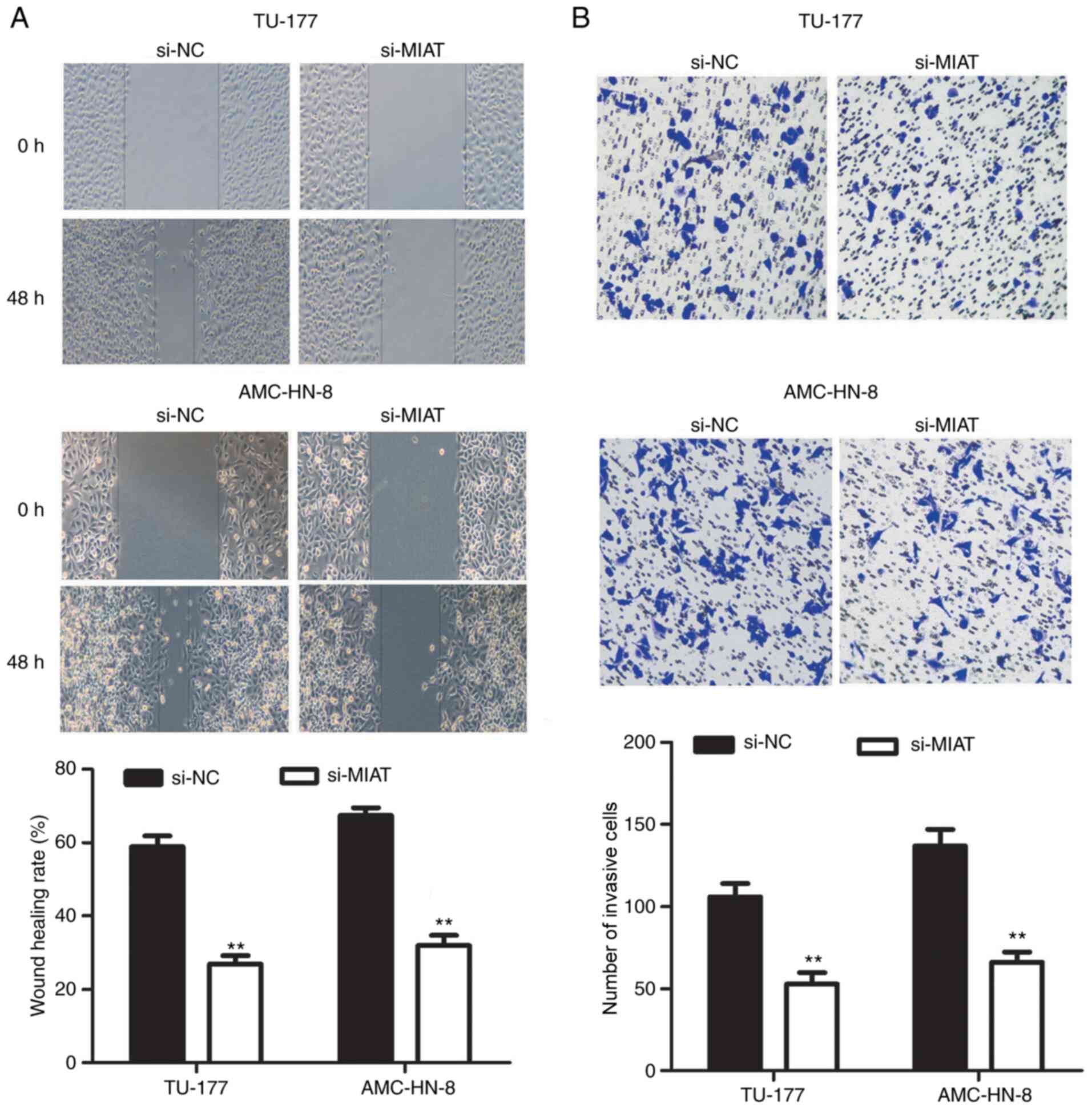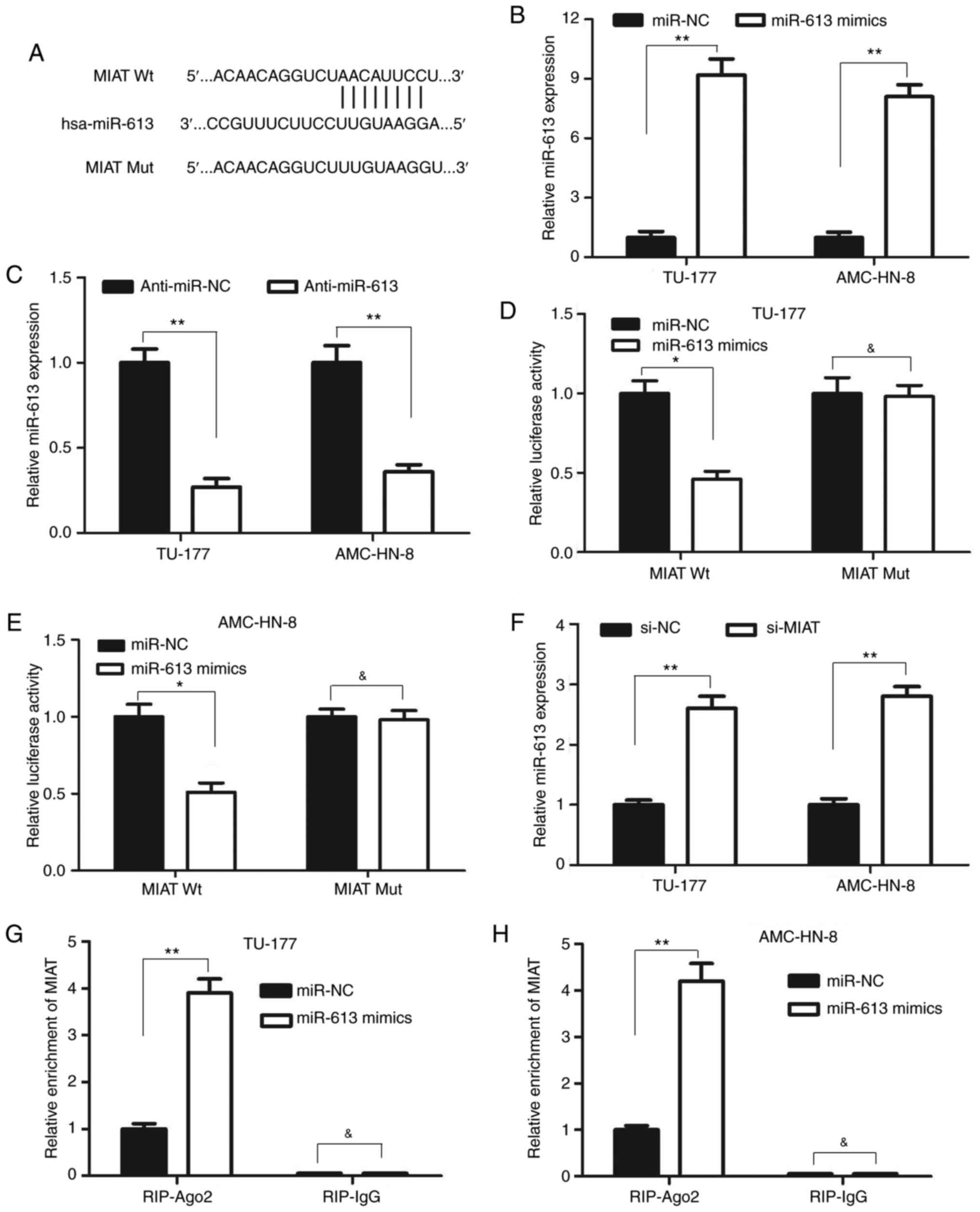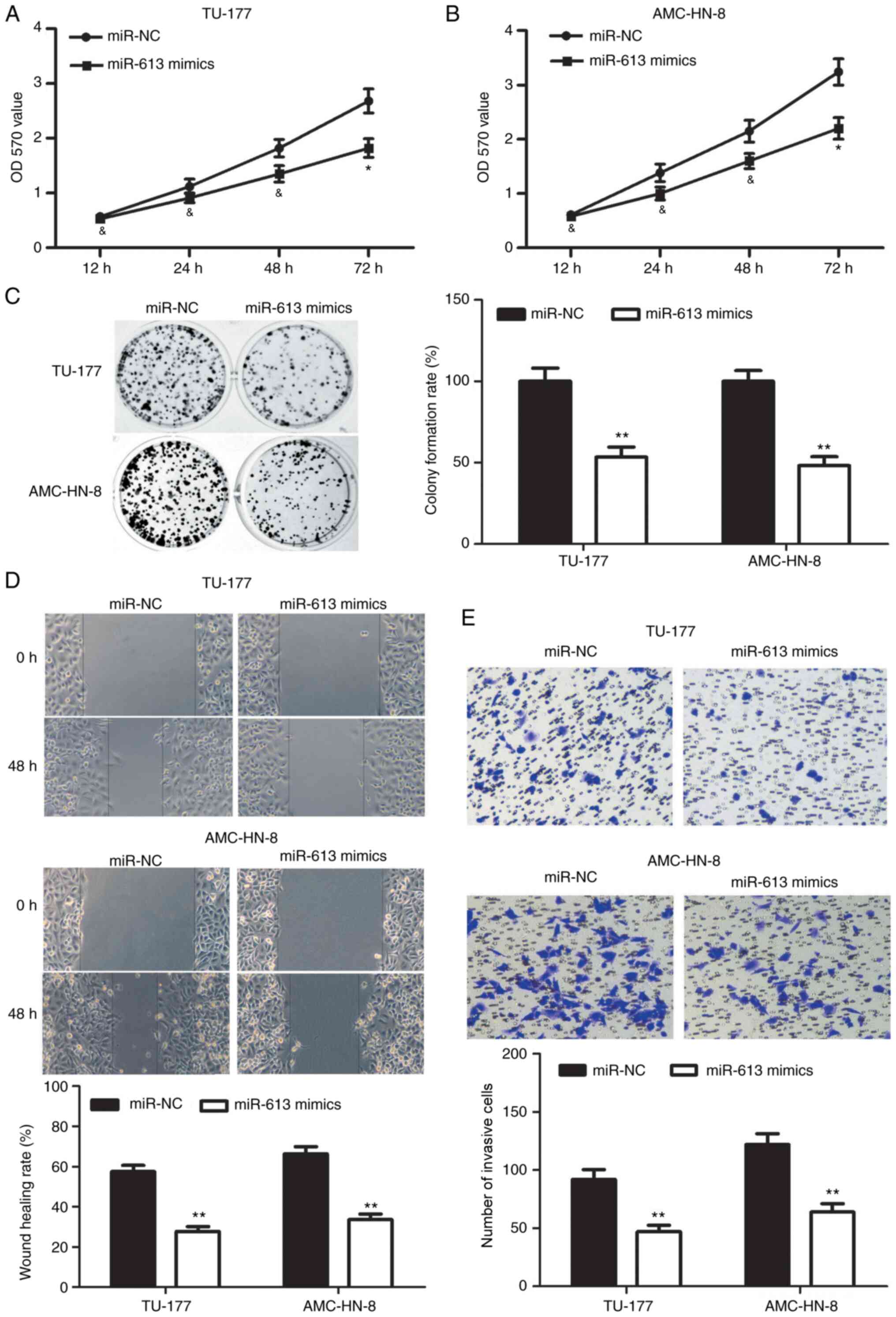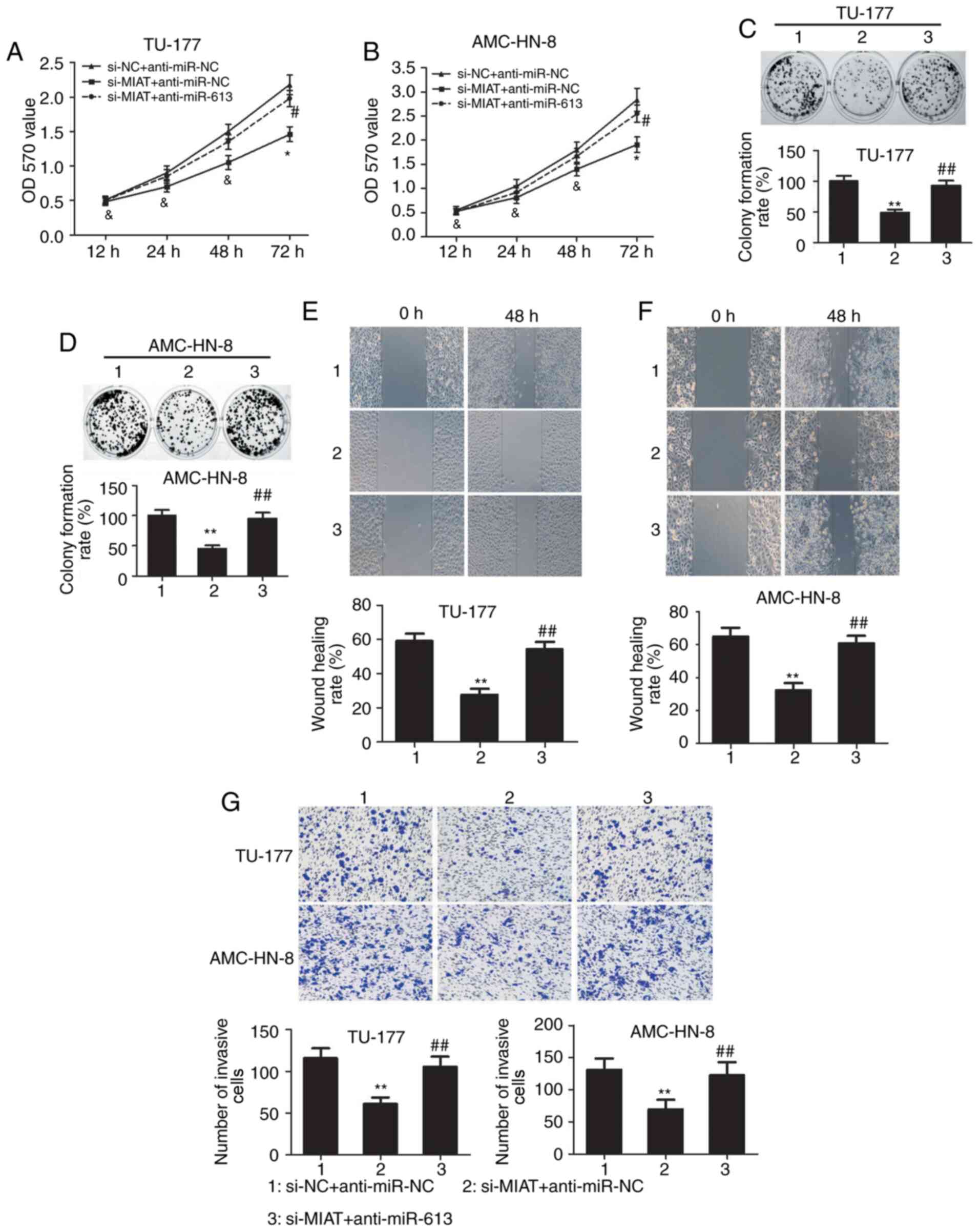|
1
|
Siegel RL, Miller KD and Jemal A: Cancer
statistics, 2015. CA Cancer J Clin. 65:5–29. 2015.PubMed/NCBI View Article : Google Scholar
|
|
2
|
Bray F, Ferlay J, Soerjomataram I, Siegel
RL, Torre LA and Jemal A: Global cancer statistics 2018: GLOBOCAN
estimates of incidence and mortality worldwide for 36 cancers in
185 countries. CA Cancer J Clin. 68:394–424. 2018.PubMed/NCBI View Article : Google Scholar
|
|
3
|
Marur S and Forastiere AA: Head and neck
squamous cell carcinoma: Update on epidemiology, diagnosis, and
treatment. Mayo Clin Proc. 91:386–396. 2016.PubMed/NCBI View Article : Google Scholar
|
|
4
|
Almadori G, Bussu F, Cadoni G, Galli J,
Paludetti G and Maurizi M: Molecular markers in laryngeal squamous
cell carcinoma: Towards an integrated clinicobiological approach.
Eur J Cancer. 41:683–693. 2005.PubMed/NCBI View Article : Google Scholar
|
|
5
|
Yang L, Froberg JE and Lee JT: Long
noncoding RNAs: Fresh perspectives into the RNA world. Trends
Biochem Sci. 39:35–43. 2014.PubMed/NCBI View Article : Google Scholar
|
|
6
|
Choudhry H, Harris AL and McIntyre A: The
tumour hypoxia induced non-coding transcriptome. Mol Aspects Med.
47-48:35–53. 2016.PubMed/NCBI View Article : Google Scholar
|
|
7
|
Peng WX, Koirala P and Mo YY:
lncRNA-mediated regulation of cell signaling in cancer. Oncogene.
36:5661–5667. 2017.PubMed/NCBI View Article : Google Scholar
|
|
8
|
Shen Z, Hao W, Zhou C, Deng H, Ye D, Li Q,
Lin L, Cao B and Guo J: Long non-coding RNA AC026166.2-001 inhibits
cell proliferation and migration in laryngeal squamous cell
carcinoma by regulating the miR-24-3p/p27 axis. Sci Rep.
8(3375)2018.PubMed/NCBI View Article : Google Scholar
|
|
9
|
Wang R, Ma Z, Feng L, Yang Y, Tan C, Shi
Q, Lian M, He S, Ma H and Fang J: lncRNA MIR31HG targets HIF1A and
P21 to facilitate head and neck cancer cell proliferation and
tumorigenesis by promoting cell-cycle progression. Mol Cancer.
17(162)2018.PubMed/NCBI View Article : Google Scholar
|
|
10
|
Wang P, Wu T, Zhou H, Jin Q, He G, Yu H,
Xuan L, Wang X, Tian L, Sun Y, et al: Long noncoding RNA NEAT1
promotes laryngeal squamous cell cancer through regulating
miR-107/CDK6 pathway. J Exp Clin Cancer Res. 35(22)2016.PubMed/NCBI View Article : Google Scholar
|
|
11
|
Hao YR, Zhang DJ, Fu ZM, Guo YY and Guan
GF: Long non-coding RNA ANRIL promotes proliferation,
clonogenicity, invasion and migration of laryngeal squamous cell
carcinoma by regulating miR-181a/Snai2 axis. Regen Ther.
11:282–289. 2019.PubMed/NCBI View Article : Google Scholar
|
|
12
|
Ishii N, Ozaki K, Sato H, Mizuno H, Saito
S, Takahashi A, Miyamoto Y, Ikegawa S, Kamatani N, Hori M, et al:
Identification of a novel non-coding RNA, MIAT, that confers risk
of myocardial infarction. J Hum Genet. 51:1087–1099.
2006.PubMed/NCBI View Article : Google Scholar
|
|
13
|
Sha M, Lin M, Wang J, Ye J, Xu J, Xu N and
Huang J: Long non-coding RNA MIAT promotes gastric cancer growth
and metastasis through regulation of miR-141/DDX5 pathway. J Exp
Clin Cancer Res. 37(58)2018.PubMed/NCBI View Article : Google Scholar
|
|
14
|
Zhang HY, Zheng FS, Yang W and Lu JB: The
long non-coding RNA MIAT regulates zinc finger E-box binding
homeobox 1 expression by sponging miR-150 and promoting cell
invasion in non-small cell lung cancer. Gene. 633:61–65.
2017.PubMed/NCBI View Article : Google Scholar
|
|
15
|
Qu Y, Xiao H, Xiao W, Xiong Z, Hu W, Gao
Y, Ru Z, Wang C, Bao L, Wang K, et al: Upregulation of MIAT
regulates LOXL2 expression by competitively binding miR-29c in
clear cell renal cell carcinoma. Cell Physiol Biochem.
48:1075–1087. 2018.PubMed/NCBI View Article : Google Scholar
|
|
16
|
Liu Z, Wang H, Cai H, Hong Y, Li Y, Su D
and Fan Z: Long non-coding RNA MIAT promotes growth and metastasis
of colorectal cancer cells through regulation of miR-132/Derlin-1
pathway. Cancer Cell Int. 18(59)2018.PubMed/NCBI View Article : Google Scholar
|
|
17
|
Barnes L, Eveson JW, Reichart P and
Sidransky D: WHO pathology and genetic classification of tumors of
head and neck tumours. 3rd edition, Lyon, IARC Press, pp107-162,
2005.
|
|
18
|
Li Y, Tao C, Dai L, Cui C, Chen C, Wu H,
Wei Q and Zhou X: MicroRNA-625 inhibits cell invasion and
epithelial-mesenchymal transition by targeting SOX4 in laryngeal
squamous cell carcinoma. Biosci Rep. 39(BSR20181882)2019.PubMed/NCBI View Article : Google Scholar
|
|
19
|
Nowinska K, Ciesielska U, Piotrowska A,
Jablonska K, Partynska A, Paprocka M, Zatonski T, Podhorska-Okolow
M and Dziegiel P: MCM5 expression is associated with the grade of
malignancy and Ki-67 antigen in LSCC. Anticancer Res. 39:2325–2335.
2019.PubMed/NCBI View Article : Google Scholar
|
|
20
|
Livak KJ and Schmittgen TD: Analysis of
relative gene expression data using real-time quantitative PCR and
the 2(-Delta Delta C(T)) method. Methods. 25:402–408.
2001.PubMed/NCBI View Article : Google Scholar
|
|
21
|
Giordano C, Barone I, Vircillo V, Panza S,
Malivindi R, Gelsomino L, Pellegrino M, Rago V, Mauro L, Lanzino M,
et al: Activated FXR inhibits leptin signaling and counteracts
tumor-promoting activities of cancer-associated fibroblasts in
breast malignancy. Sci Rep. 6(21782)2016.PubMed/NCBI View Article : Google Scholar
|
|
22
|
Li D, Li DQ, Liu D and Tang XJ: miR-613
induces cell cycle arrest by targeting CDK4 in non-small cell lung
cancer. Cell Oncol (Dordr). 39:139–147. 2016.PubMed/NCBI View Article : Google Scholar
|
|
23
|
Cai H, Yao J, An Y, Chen X, Chen W, Wu D,
Luo B, Yang Y, Jiang Y, Sun D and He X: lncRNA HOTAIR acts a
competing endogenous RNA to control the expression of notch3 via
sponging miR-613 in pancreatic cancer. Oncotarget. 8:32905–32917.
2017.PubMed/NCBI View Article : Google Scholar
|
|
24
|
Xiong H, Yan T, Zhang W, Shi F, Jiang X,
Wang X, Li S, Chen Y, Chen C and Zhu Y: miR-613 inhibits cell
migration and invasion by downregulating Daam1 in triple-negative
breast cancer. Cell Signal. 44:33–42. 2018.PubMed/NCBI View Article : Google Scholar
|
|
25
|
Marioni G, Marchese-Ragona R, Cartei G,
Marchese F and Staffieri A: Current opinion in diagnosis and
treatment of laryngeal carcinoma. Cancer Treat Rev. 32:504–515.
2006.PubMed/NCBI View Article : Google Scholar
|
|
26
|
Menach P, Oburra HO and Patel A: Cigarette
smoking and alcohol ingestion as risk factors for laryngeal
squamous cell carcinoma at Kenyatta National Hospital, Kenya. Clin
Med Insights Ear Nose Throat. 5:17–24. 2012.PubMed/NCBI View Article : Google Scholar
|
|
27
|
Nix P, Cawkwell L, Patmore H, Greenman J
and Stafford N: Bcl-2 expression predicts radiotherapy failure in
laryngeal cancer. Br J Cancer. 92:2185–2189. 2005.PubMed/NCBI View Article : Google Scholar
|
|
28
|
Mesolella M, Iorio B, Misso G, Luce A,
Cimmino M, Iengo M, Landi M, Sperlongano P, Caraglia M and
Ricciardiello F: Role of perineural invasion as a prognostic factor
in laryngeal cancer. Oncol Lett. 11:2595–2598. 2016.PubMed/NCBI View Article : Google Scholar
|
|
29
|
Chu EA and Kim YJ: Laryngeal cancer:
Diagnosis and preoperative work-up. Otolaryngol Clin North Am.
41:673–695. 2008.PubMed/NCBI View Article : Google Scholar
|
|
30
|
Cossu AM, Mosca L, Zappavigna S, Misso G,
Bocchetti M, De Micco F, Quagliuolo L, Porcelli M, Caraglia M and
Boccellino M: Long non-coding RNAs as important biomarkers in
laryngeal cancer and other head and neck tumours. Int J Mol Sci.
20(3444)2019.PubMed/NCBI View Article : Google Scholar
|
|
31
|
Ekmekci CG, Coskunpinar E, Avci H, Farooqi
AA, Orhan KS and Akbas F: Integrative analysis of mRNA and microRNA
expression profiles in laryngeal squamous cell carcinoma. J Cell
Biochem. 120:3415–3422. 2019.PubMed/NCBI View Article : Google Scholar
|
|
32
|
Zhao X, Zhang W and Ji W: miR-196b is a
prognostic factor of human laryngeal squamous cell carcinoma and
promotes tumor progression by targeting SOCS2. Biochem Biophys Res
Commun. 501:584–592. 2018.PubMed/NCBI View Article : Google Scholar
|
|
33
|
Takeuchi T, Kawasaki H, Luce A, Cossu AM,
Misso G, Scrima M, Bocchetti M, Ricciardiello F, Caraglia M and
Zappavigna S: Insight toward the microRNA profiling of laryngeal
cancers: Biological role and clinical impact. Int J Mol Sci.
21(3693)2020.PubMed/NCBI View Article : Google Scholar
|
|
34
|
Kawasaki H, Takeuchi T, Ricciardiello F,
Lombardi A, Biganzoli E, Fornili M, De Bortoli D, Mesolella M,
Cossu AM, Scrima M, et al: Definition of miRNA signatures of nodal
metastasis in LCa: miR-449a targets notch genes and suppresses cell
migration and invasion. Mol Ther Nucleic Acids. 20:711–724.
2020.PubMed/NCBI View Article : Google Scholar
|
|
35
|
Ricciardiello F, Capasso R, Kawasaki H,
Abate T, Oliva F, Lombardi A, Misso G, Ingrosso D, Leone CA, Iengo
M and Caraglia M: A miRNA signature suggestive of nodal metastases
from laryngeal carcinoma. Acta Otorhinolaryngol Ital. 37:467–474.
2017.PubMed/NCBI View Article : Google Scholar
|
|
36
|
Lian Y, Li Z, Fan Y, Huang Q, Chen J, Liu
W, Xiao C and Xu H: The lncRNA-HOXA-AS2/EZH2/LSD1 oncogene complex
promotes cell proliferation in pancreatic cancer. Am J Transl Res.
9:5496–5506. 2017.PubMed/NCBI
|
|
37
|
Liu XM, Yang B and Han J: Increased long
noncoding RNA LINP1 expression and its prognostic significance in
human breast cancer. Eur Rev Med Pharmacol Sci. 22:8749–8754.
2018.PubMed/NCBI View Article : Google Scholar
|
|
38
|
Li H, Tian G, Tian F and Shao L: Long
non-coding RNA TUG1 promotes osteosarcoma cell proliferation and
invasion through inhibition of microRNA-212-3p expression. Exp Ther
Med. 16:779–787. 2018.PubMed/NCBI View Article : Google Scholar
|
|
39
|
Zhang G, An X and Zhao H, Zhang Q and Zhao
H: Long non-coding RNA HNF1A-AS1 promotes cell proliferation and
invasion via regulating miR-17-5p in non-small cell lung cancer.
Biomed Pharmacother. 98:594–599. 2018.PubMed/NCBI View Article : Google Scholar
|
|
40
|
Liu Y, Zhou J, Wang S, Song Y, Zhou J and
Ren F: Long non-coding RNA SNHG12 promotes proliferation and
invasion of colorectal cancer cells by acting as a molecular sponge
of microRNA-16. Exp Ther Med. 18:1212–1220. 2019.PubMed/NCBI View Article : Google Scholar
|
|
41
|
Guan GF, Zhang DJ, Wen LJ, Xin D, Liu Y,
Yu DJ, Su K, Zhu L, Guo YY and Wang K: Overexpression of lncRNA
H19/miR-675 promotes tumorigenesis in head and neck squamous cell
carcinoma. Int J Med Sci. 13:914–922. 2016.PubMed/NCBI View Article : Google Scholar
|
|
42
|
Zhang Z, Wang X, Cao S, Han X, Wang Z,
Zhao X, Liu X, Li G, Pan X and Lei D: The long noncoding RNA TUG1
promotes laryngeal cancer proliferation and migration. Cell Physiol
Biochem. 49:2511–2520. 2018.PubMed/NCBI View Article : Google Scholar
|
|
43
|
Zheng X, Zhao K, Liu T, Liu L, Zhou C and
Xu M: Long noncoding RNA PVT1 promotes laryngeal squamous cell
carcinoma development by acting as a molecular sponge to regulate
miR-519d-3p. J Cell Biochem. 120:3911–3921. 2019.PubMed/NCBI View Article : Google Scholar
|
|
44
|
Zhao J, Lv K, Li ZH, Wu J, Gao W, Wong TS,
Luo J, Qin H, Wang B, Fu Q and Lei WB: Functional significance of
the long non-coding RNA RP11-169D4.1 as a metastasis suppressor in
laryngeal squamous cell carcinoma by regulating CDH1. Oncol Rep.
38:211–220. 2017.PubMed/NCBI View Article : Google Scholar
|
|
45
|
Cui X, Fang N, Cui Y, Xiao D and Wang X:
Long non-coding RNA NEF inhibits proliferation and promotes
apoptosis of laryngeal squamous cell carcinoma cells by inhibiting
Wnt/β-catenin signaling. Oncol Lett. 17:4928–4934. 2019.PubMed/NCBI View Article : Google Scholar
|
|
46
|
Zhang X, Wu N, Wang J and Li Z: lncRNA
MEG3 inhibits cell proliferation and induces apoptosis in laryngeal
cancer via miR-23a/APAF-1 axis. J Cell Mol Med. 23:6708–6719.
2019.PubMed/NCBI View Article : Google Scholar
|
|
47
|
Liu W, Wang Z, Wang C and Ai Z: Long
non-coding RNA MIAT promotes papillary thyroid cancer progression
through upregulating LASP1. Cancer Cell Int. 19(194)2019.PubMed/NCBI View Article : Google Scholar
|
|
48
|
Yang Y, Zhang Z, Wu Z, Lin W and Yu M:
Downregulation of the expression of the lncRNA MIAT inhibits
melanoma migration and invasion through the PI3K/AKT signaling
pathway. Cancer Biomark. 24:203–211. 2019.PubMed/NCBI View Article : Google Scholar
|
|
49
|
Lin D, Xu HP, Lin JH, Hu HH, Wang Q and
Zhang J: Long non-coding RNA MIAT promotes non-small cell lung
cancer progression by sponging miR-1246. Eur Rev Med Pharmacol Sci.
23:5795–5801. 2019.PubMed/NCBI View Article : Google Scholar
|
|
50
|
Kartha RV and Subramanian S: Competing
endogenous RNAs (ceRNAs): New entrants to the intricacies of gene
regulation. Front Genet. 5(8)2014.PubMed/NCBI View Article : Google Scholar
|
|
51
|
Russo F, Fiscon G, Conte F, Rizzo M, Paci
P and Pellegrini M: Interplay between long noncoding RNAs and
microRNAs in cancer. Methods Mol Biol. 1819:75–92. 2018.PubMed/NCBI View Article : Google Scholar
|
|
52
|
Denzler R, McGeary SE, Title AC, Agarwal
V, Bartel DP and Stoffel M: Impact of microRNA levels, target-site
complementarity, and cooperativity on competing endogenous
RNA-regulated gene expression. Mol Cell. 64:565–579.
2016.PubMed/NCBI View Article : Google Scholar
|
|
53
|
Li WT, Wang BL, Yang CS, Lang BC and Lin
YZ: miR-613 promotes cell proliferation and invasion in cervical
cancer via targeting PTPN9. Eur Rev Med Pharmacol Sci.
22:4107–4114. 2018.PubMed/NCBI View Article : Google Scholar
|
|
54
|
Yang X, Zhang L, Song X, He W, Zhang D, Lu
Q, Wu J, Wu C and Jiang J: MicroRNA-613 promotes colon cancer cell
proliferation, invasion and migration by targeting ATOH1. Biochem
Biophys Res Commun. 504:827–833. 2018.PubMed/NCBI View Article : Google Scholar
|
|
55
|
Wu J, Yuan P, Mao Q, Lu P, Xie T, Yang H
and Wang C: miR-613 inhibits proliferation and invasion of breast
cancer cell via VEGFA. Biochem Biophys Res Commun. 478:274–278.
2016.PubMed/NCBI View Article : Google Scholar
|
|
56
|
Lu Y, Tang L, Zhang Q, Zhang Z and Wei W:
MicroRNA-613 inhibits the progression of gastric cancer by
targeting CDK9. Artif Cells Nanomed Biotechnol. 46:980–984.
2018.PubMed/NCBI View Article : Google Scholar
|
|
57
|
Wang J, Yang S, Ge W, Wang Y, Han C and Li
M: miR-613 suppressed the laryngeal squamous cell carcinoma
progression through regulating PDK1. J Cell Biochem. 119:5118–5125.
2018.PubMed/NCBI View Article : Google Scholar
|



